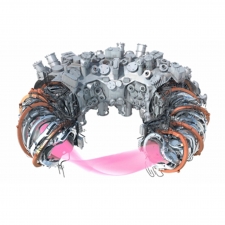Getting closer to harness thermonuclear fusion
03-02-2016
A new phase of research on Wendelstein 7-X (W7-X) was solemnly inaugurated on February 3, 2016 at the Max Planck Institute for Plasma Physics (IPP) in Greifswald (Germany). The ceremony was attended by numerous politicians (in the first place Angela Merkel, Chancellor of Germany), scientists, and engineers from countries involved in the project. Polish contribution included assembly works on superconducting cables/bus bars (the PAN Institute of Nuclear Physics in Cracow); design works and structural analyses of magnetic systems and soft X-ray diagnostics systems (Warsaw University of Technology, Institute of Plasma Physics & Laser Micro Fusion in Warsaw, Opole University); delivery of neutral beam injector elements including injector chamber base with a hydraulic levelling system, reflex magnets, gate valves including annealing systems, cooling system (NCBJ).
„Our about 6.5 million Euro worth contribution to the project allowed us to acquire know-how helping to increase competitiveness of Polish entrepreneurs on international markets. However, first of all it has allowed us to join global efforts to find a friendly energy source for the future” – pointed out Professor Krzysztof Kurek, NCBJ Director General, who attended the ceremony. – „Our scientists are participating in works of all W7-X research teams. They will be co-authors of all fusion-related publications/patents and will co-shape directions of the to-be-conducted research. We hope that the joint efforts will greatly help us to deepen our understanding of all phenomena occurring during thermonuclear fusion and to facilitate practical harnessing of that powerful source of energy.”
Assembly works were completed in April 2014. Since then all major sub-systems of the W7-X facility (chamber pumping system, cooling system, superconducting coils and the magnetic field they produce, control system, heating devices, measuring instruments) have been tested and prepared for operation.
“On December 10, 2015 operators started the magnetic field up and initiated the experiment” – explained Professor Jacek Jagielski, Director of NCBJ Material Physics Department. – “Control system fed around one milligram of helium gas into evacuated plasma vessel of the facility and switched on a short 1,3 megawatt microwave heating pulse. The first plasma confined for about one tenth of a second achieved a temperature of around one million degrees. This undoubtedly was a great success and a milestone towards reaching the W7-X project objectives”.
To extend duration of the helium plasma confinement and to optimize the microwave heating method is the next task. Start of experimentation with hydrogen plasma, the real object of fusion research, is expected still this year. The objective of the research is to develop a power source friendly to the climate which would harvest energy from fusion of light nuclei – just like our Sun does. As the fusion fires ignite only at temperatures above 100 million degrees, the fuel – a thin hydrogen plasma – must not come into contact with cold vessel walls. Confined by magnetic fields, it floats inside the device vacuum chamber virtually not touching anything.
Basically, two types of magnetic traps are studied: tokamaks and stellarators. At present, tokamaks seem to be closer to practical applications (see e.g. ITER international test fusion facility currently under construction in Cadarache, France). Wendelstein 7-X, the world's largest stellarator-type fusion device, is not expected to produce any net energy. Instead, it should help us to better understand all phenomena occurring during thermonuclear fusion because of its fundamental advantage: ability to operate continuously (as opposite to tokamaks that can be operated only in the pulse mode). Such knowledge is indispensable to construct and successfully operate thermonuclear power plants. Fusion-based power industry has already been hailed as the future solution for all energy problems of the world.





